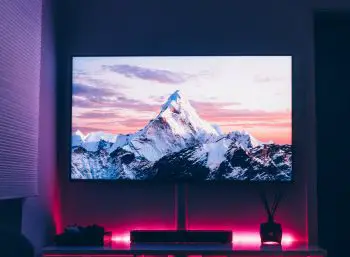Introduction
If you’re in the process of deciding on outfitting your home theater with the best TVs, speakers, and receivers, you often find yourself looking at Samsung or Sony brands. These two companies are at the pinnacle of providing people with the most diverse and high-quality options on the market right now.
It’s easy to get lost in all of the comparison details and opinions between which brand is better on the Internet. When my family moved to their new house and was deciding on what TV and speaker system to get, we encountered the same confusion on which brand we really wanted to go with.
I did the most thorough research on this topic so you don’t have to. This article is a compilation of everything I found and from my personal experience.Home theater system companies actually do differ even though images and sound might look/sound the same at first glance.
This article is broken down by comparing the most popular and highly rated brands of Sony and Samsung. Furthermore, this article analyze their products on specifically their TVs and speaker systems.
Table of Contents
Sound Systems Compared
TV Systems Compared
Choosing a Receiver
Choosing a Projector
Sound Systems Compared
Sony:
They’re able to utilize and produce Dolby Atmos DTS X quality. This is the latest surround sound technology for home theaters and it’s hard to do any better than that from your own home. In general, Sony sound systems are notorious for producing the highest sound quality possible and their products always push the boundaries in terms of exceptional quality.
Sony also uses s-force pro and a vertical sound engine to create a 7.1.2 surround sound effect even with their soundbars.
Drawbacks:
Sony’s products generally come with too many controllers and manual set up requirements. You have to be a little bit tech savvy to set up their products for optimal settings or follow their user manuals. Samsung sound systems are simpler (including their remote button options) and it’s more of a plug and play for Samsung.
Samsung only has Doubly Digital and DTS surround formats, which is no where near the level of sound quality and crispness that Sony produces through Doubly Atmos DTS technology.
Samsung sound bars typically come in a 5.1 setup with no surround sound speakers (unless you add them yourself). Their soundbars use acoustic beam so even without external rear speakers, sound appears to come from the direction or exact location that you see it on the TV.
Overall Takeaways
When I compared several different Sony and Samsung products that are general equivalent to each other in scale and features, these were my concluding findings:
Best Price / Bang for the Buck : Sony
Sound Quality: Sony
User-friendliness: Samsung
TV Systems Compared
Samsung:
Traditionally, Samsung makes their TVs a lot thinner than Sony. They’re easier to mount to a wall if you have a small sized room with not a lot of wall space. It’s also a good option if you don’t want your TV sticking out of the wall.
Having a TV flat against the the surface makes for a convenient set up. Another great feature of Samsun TVs is that they have a 5:5 pull down. This means panning looks smooth and motion blur is adjusted appropriately. You can look more into what Pulldown is but it’s beyond the scope of this article.
Drawbacks:
Samsung’s TVs usually have a built in blooming effect, meaning that the TV will purposely and subtly darken elements of the screen. This effect makes dark scenes feel darker and images won’t blast your eyes out when watching action movies in the dark.
Recommendation:
Invest in one of Samsung’s QLED TV’s (Quantum Dot Display). This is just like an OLED where individually pixels are lighted at a time and not by a surrounding white LED light. This obliterates all the drawbacks of Samsung’s back light bleed effect.
Sony:
Sony produces TV systems that are known for superior motion handling capabilities. Their images have more clarity and little back light bleed. Sony TVs generally achieve higher motion picture quality and easily display bright and contrasting images.
Drawbacks:
Dark images can sometimes look too bright unless you’re viewing on an OLED display. Sony doesn’t account for LED back lighting during dark scenes in movies or video games. Sometimes you’ll see some of the LED back lighting on the side of the screen. It’s not significant, but it’s noticeable. Most people won’t mind this, but it’s good to be aware.
Recommendation:
Adjust the settings on your Sony TV and get familiar with the various display options. After you become well versed in your Sony TV, you can easily mitigate the drawbacks that they initially come with.
Overall Takeaways
Best Price / Bang for the Buck : Sony
Image Quality and Motion Handling: Sony
Better Control Over Backlight Bleed: Samsung
Choosing a Receiver
When it comes to selecting a receiver for your entire system, my recommendation is to find one that fits your needs and your budget. Higher end receivers are only necessary for people who are super super in-tune to audio transmission quality and can tell the difference between a decent receiver and an outstanding one.
You’ll be able to easily mix a Samsung and a Sony receiver based on your sound system. When it actually comes to receivers, Samsung and Sony are not the reigning champions.
Yamaha tends to dominate the market for a home theater receivers. If you’re looking for a good budget receiver because you simply need to consolidate all your sound connections, then I would go with this one.
If You’re Set on Purchasing a Soundbar
My family has had to return a Sony soundbar after trying a couple of their products and realizing it wasn’t what we were looking for. We have Sony speakers for out home theater set-up, but not for our living room TV. When it came to our living room TV set up, we decided to go with the Sonos Beam.
It provides much better audio quality for dialogue, especially in scenes where you otherwise wouldn’t be able to fully understand what the characters are saying. We also wanted to hook it up to Alexa instead of always having to use a remote.
Sonos soundbars stand above the rest because they are able to manage low frequencies a lot better than other soundbars. Gunshots, explosions, and even the most subtle sound effects come out great.
The Base of our Sonos system is clear and playing background music during parties or a home workout more than exceeds intial expectations. Whatever technology Sonos is using, their speakers do a great job boosting dialogue without overwhelming you with loud sound effects.
Choosing a Projector
Samsung doesn’t really make noteworthy projectors so it’s not really fair to stack them up against Sony. Sony projectors are great, but their products are way too overpriced compared to other projector companies like Epson. Sony makes really expensive, high-end projectors that cost up to $4000. The last time I demoed one at Best Buy, I felt that the projector I already had at home provided the same level of quality!
When it comes to projectors, I personally recommend going with Epson. I’ve demoed a lot of Sony projectors and found that Epson provides the highest quality for the most affordable price. You can check out my favorite projector here.
Conclusion
Ultimately, choosing between Samsung or Sony all depends on how you listen. This article highlighted some of the unique properties that each of the two companies builds into their products.
Choosing a good sound system and a TV always depends on your personal situation. From all the research I’ve done, I have decided for myself that Sony is the winner for both the TV and the sound system. They always stand out in small ways just a little bit more than Samsung.
Thanks for reading! If you have any questions or comments, feel free to reach out at the email I provide in some of my other articles. I don’t include it every time to avoid spam but I will do my best to respond if you want to reach out for any reason. The site is all about helping create the most ideal man cave, home theater, gaming room set up.

